Awards and decorations of Nazi Germany were military, political, and civilian decorations that were bestowed between 1923 and 1945, first by the Nazi Party and later the state of Nazi Germany.

The War Order of the German Cross, normally abbreviated to the German Cross or Deutsches Kreuz, was instituted by Adolf Hitler on 28 September 1941. It was awarded in two divisions: in gold for repeated acts of bravery or military leadership; and in silver for distinguished non-combat war service. The German Cross in Gold ranked higher than the Iron Cross First Class but below the Knight's Cross of the Iron Cross, while the German Cross in Silver ranked higher than the War Merit Cross First Class with Swords but below the Knight's Cross of the War Merit Cross with Swords.
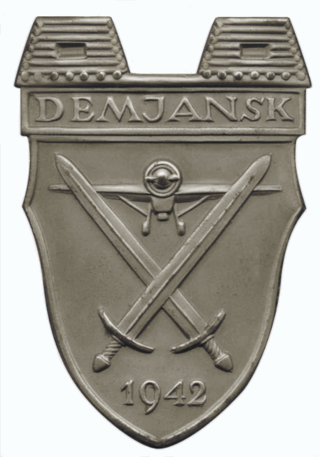
Demyansk Shield was a World War II German military decoration awarded to Wehrmacht personnel who fought in the Demyansk pocket on the Eastern Front in the early months of 1942. The pocket of German troops had been encircled and cut off by the Red Army around Demyansk (Demjansk), south of Leningrad, and was successfully defended with the aid of an airbridge. The shield was instituted on 25 April 1943 by Adolf Hitler and was not bestowed after 1 July 1944.

The Kuban Shield was a World War II military decoration of Nazi Germany. It was awarded to Wehrmacht forces who fought at the Kuban bridgehead in the Soviet Union from February 1943 until it was abandoned in October 1943. The award was instituted on 21 September 1943.

The Narvik Shield was a World War II German military decoration awarded to all German forces that took part in the battles of Narvik between 9 April and 8 June 1940. It was instituted on 19 August 1940 by Adolf Hitler. The Oberkommando der Wehrmacht (OKW) published the order the same day. It was bestowed by General Eduard Dietl, the commander of Army Group Narvik.
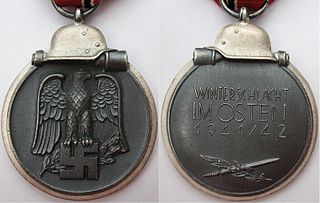
The Eastern Medal, officially the Winter Battle in the East 1941–42 Medal, was a military award of the Wehrmacht which was created by ordinance of Adolf Hitler on 26 May 1942.
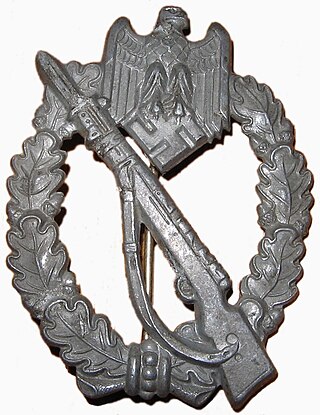
The Infantry Assault Badge was a German military decoration awarded to Waffen-SS and Wehrmacht Heer soldiers during the Second World War. This decoration was instituted on 20 December 1939 by the Commander-in-Chief (Oberbefehlshaber) of the German Army, Generalfeldmarschall Walther von Brauchitsch. It could be awarded to members of infantry and Gebirgsjäger units that had participated in infantry assaults, with light infantry weapons, on at least three separate days of battle in the front line on or after 1 January 1940. When a counter-offensive led to fighting, it could also apply. Award of the Infantry Assault Badge was authorized at regimental command level, and mechanized or motorized infantry were not eligible for the original badge. A bronze variant of the Infantry Assault Badge was created in June 1940, authorized for motorized and mechanized infantry units, using similar requirements for award as the original silver variant. Non-infantry personnel were not eligible for either grade of the Infantry Assault Badge, but were eligible for other combat recognition badges, usually the General Assault Badge, Close Combat Clasp, or the Panzer Badge. The Luftwaffe would develop its own ground combat badge in 1942, the Ground Assault Badge.

The Close Combat Clasp was a World War II German military award instituted on 25 November 1942 for participation in hand-to-hand fighting at close quarters. Intended primarily for infantry, other Wehrmacht, Waffen-SS, ground Luftwaffe units and paratroopers were also eligible.
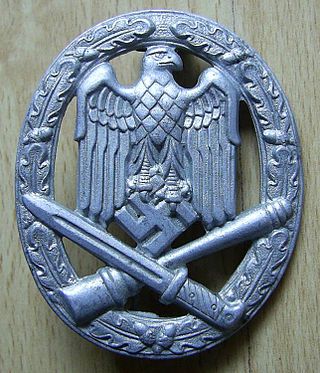
The General Assault Badge was a military decoration awarded during World War II to personnel of the German Army, Waffen-SS and Ordnungspolizei who supported an infantry attack but were not part of specific infantry units and therefore did not qualify for the Infantry Assault Badge. It was instituted by General Walther von Brauchitsch on 1 June 1940.

The Crimea Shield was a World War II German military decoration. It was awarded to military personnel under the command of Field Marshal von Manstein, including supporting naval and air force units, who fought against Soviet Red Army forces between 21 September 1941 and 4 July 1942 and who captured the Crimea region. It was instituted on 25 July 1942. It was the most widely distributed of the various German campaign shields, with approximately 250,000 awarded.
The Honour Roll Clasp was a decoration of Nazi Germany during World War II. There were different versions for the Army (Heer), Air Force (Luftwaffe) and Navy (Kriegsmarine).
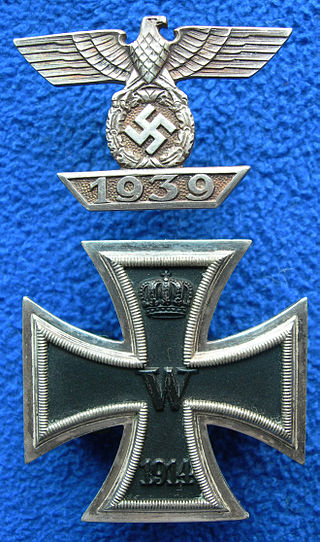
The Clasp to the Iron Cross was a white metal medal clasp displayed on the uniforms of German Wehrmacht personnel who had been awarded the Iron Cross in World War I, and who again qualified for the decoration in World War II.
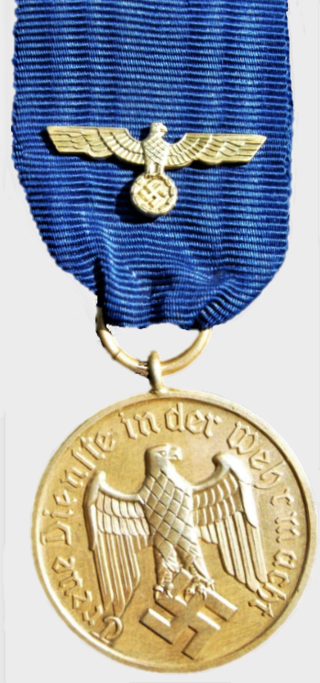
The Wehrmacht Long Service Award was a military service decoration of Nazi Germany issued for satisfactory completion of a number of years in military service.
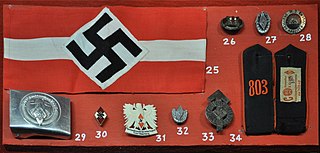
The Hitler Youth Badge was a political decoration of Nazi Germany, awarded for various degrees of service to the Hitler Youth, (Hitler Jugend). The badge was first created in 1929, with formal regulations for presentation as a decoration formalized from 1933. In addition, the Hitler Youth introduced a number of other awards for merit and proficiency.
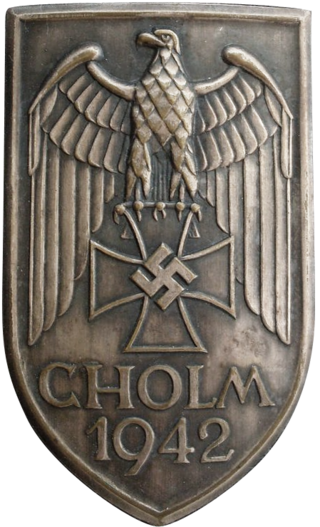
The Cholm Shield was a World War II German military decoration awarded to those who fought in the Cholm Pocket on the Eastern Front between 21 January and 5 May 1942. It was instituted on 1 July 1942 and is the rarest of the German combat shields, with approximately 5,500 recipients. Awards ceased to be bestowed on 1 April 1943.

The Africa Cuff Title, or Africa Cuff Band, was a World War II German military decoration awarded to members of the Wehrmacht who took part in the North African campaign of 1941–43.
The Metz 1944 Cuff Title, or Metz 1944 Cuff Band, was a World War II German military decoration instituted to reward members of the Wehrmacht who took part in the 1944 battle of Metz.

The Warsaw Shield,, or Warsaw Arm Shield, was a planned World War II German military decoration intended for award to Wehrmacht and Waffen-SS servicemen who took part in the suppression of the 1944 Warsaw uprising. Although authorised, with the conditions of award and the design approved and announced, production had not begun prior to the end of the war and the award was never issued.

The Condor Legion Tank Badge was a German military decoration awarded to tank crews who served with the German Condor Legion during the Spanish Civil War, 1936–1939.

The Driver Proficiency Badge was a German military badge awarded to drivers of military transport vehicles during World War II.



















